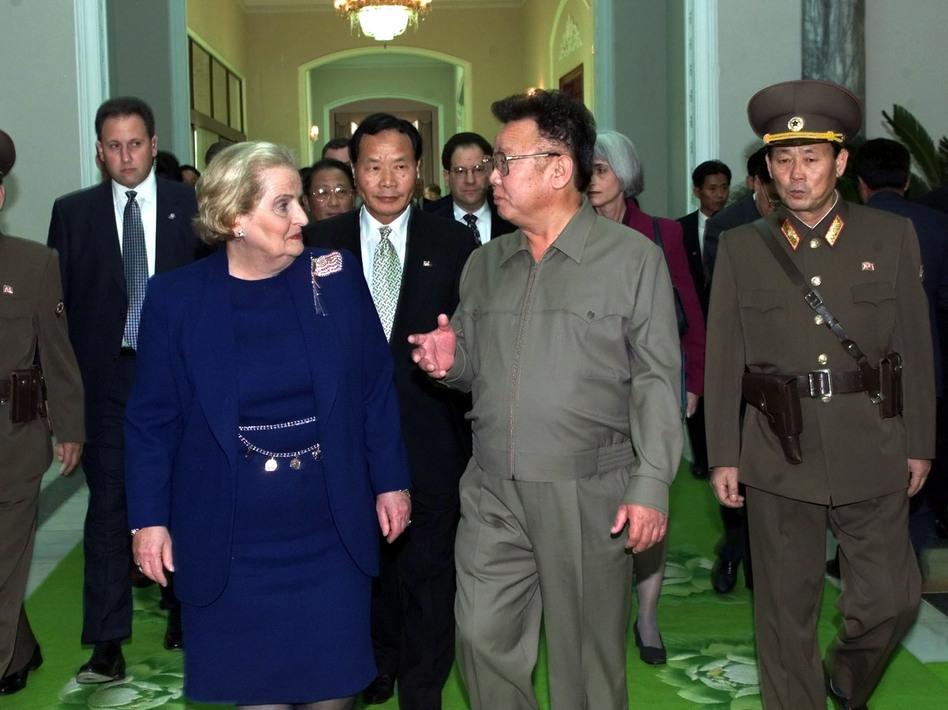When Madeleine Albright Met Kim Jong-il: A Diplomatic Dance in the Shadows

North Korean leader Kim Jong Il and Secretary of State Madeleine Albright met in Pyongyang on Oct. 23, 2000. Tong Kim (between Albright and Kim) served as the State Department interpreter.
Introduction:
The meeting between former U.S. Secretary of State Madeleine Albright and North Korean leader Kim Jong-il in the year 2000 stands as a pivotal moment in diplomatic history, offering a rare glimpse into the complexities of international relations and the pursuit of peace on the Korean Peninsula. This extensive article delves into the context, the intricacies of the meeting, and the enduring impact it had on diplomatic relations between the United States and North Korea.
I. Historical Context:
- The Fractured Peninsula: At the turn of the millennium, the Korean Peninsula remained divided, with North and South Korea existing as two separate entities with a history marred by conflict. The Korean War of the 1950s had resulted in an armistice, not a formal peace treaty, leaving the two nations in a state of uneasy truce.
- Emerging Nuclear Concerns: The late 1990s and early 2000s saw rising concerns over North Korea’s nuclear program. The reclusive nation’s pursuit of nuclear weapons became a focal point of international attention, triggering a delicate dance between diplomatic engagement and geopolitical tensions.
II. Madeleine Albright’s Diplomatic Odyssey:
- Secretary of State’s Diplomatic Prowess: Madeleine Albright, the first female U.S. Secretary of State, was known for her diplomatic acumen and strategic approach to international relations. Her tenure coincided with a period of increased engagement with North Korea, seeking avenues for dialogue amid rising concerns over nuclear proliferation.
- Diplomatic Outreach to Pyongyang: Albright’s diplomatic overtures toward North Korea were grounded in the belief that engagement and dialogue could pave the way for a more stable and secure Korean Peninsula. The decision to meet with Kim Jong-il was a calculated step, representing a willingness to engage directly with a leader often shrouded in mystery.
III. The Meeting:
- Unprecedented Encounter: The meeting between Albright and Kim Jong-il in Pyongyang in October 2000 marked an unprecedented encounter between high-level representatives of the United States and North Korea. The secrecy surrounding the North Korean regime added an air of mystery to the meeting, heightening its significance.
- The Human Element: Albright’s visit humanized the diplomatic process, showcasing the personal interactions between leaders. The meeting sought to transcend the political posturing and offer a more nuanced understanding of the individuals shaping the geopolitical landscape.
IV. Intricacies of Diplomacy:
- Nuclear Negotiations: Central to the discussions was North Korea’s nuclear program. Albright’s visit aimed to explore the possibility of a diplomatic resolution to curb the development of nuclear weapons, addressing the concerns of the international community.
- Cultural Nuances: Diplomatic encounters with North Korea require an understanding of the nation’s unique cultural and political context. Albright’s diplomatic team navigated cultural nuances, acknowledging the importance of protocol and symbolism in North Korean interactions.
V. Aftermath and Impact:
- Legacy of the Meeting: Albright’s meeting with Kim Jong-il left an indelible mark on the diplomatic landscape. While it did not immediately lead to a comprehensive resolution, the encounter opened channels for ongoing dialogue and set the stage for future negotiations.
- Complexities of North Korean Relations: The complexities of dealing with North Korea became evident in the years that followed. The nation’s unpredictable behavior, coupled with shifting geopolitical dynamics, posed ongoing challenges to diplomatic efforts aimed at achieving lasting stability in the region.
VI. Criticisms and Controversies:
- Skepticism and Criticism: Albright’s diplomatic approach faced skepticism and criticism from some quarters. Critics argued that engaging with the North Korean regime might legitimize its actions or that the secretive nation could exploit diplomatic overtures for its strategic advantage.
- Limited Tangible Results: While the meeting was a landmark event, the tangible results in terms of denuclearization were limited. The subsequent years witnessed a complex ebb and flow in diplomatic relations, with moments of optimism followed by setbacks.
VII. Lessons Learned:
- The Importance of Dialogue: Albright’s meeting underscored the importance of dialogue in international relations, emphasizing the need to communicate directly with even the most reclusive regimes. The encounter highlighted the potential for understanding and collaboration amid geopolitical tensions.
- Navigating Diplomatic Challenges: The meeting with Kim Jong-il showcased the delicate balance required in navigating diplomatic challenges. Albright’s strategic approach and diplomatic finesse became lessons for future engagements with North Korea and similar geopolitical scenarios.
VIII. Contemporary Relevance:
- Ongoing Challenges: The diplomatic landscape on the Korean Peninsula continues to evolve. Ongoing efforts to address North Korea’s nuclear capabilities underscore the enduring challenges and the need for sustained diplomatic engagement.
- Current Developments: Subsequent administrations have grappled with the North Korean challenge, with varying degrees of success and setbacks. The legacy of Albright’s meeting remains relevant as global leaders navigate the complexities of dealing with a nation that remains a geopolitical enigma.
IX. Conclusion:
The meeting between Madeleine Albright and Kim Jong-il stands as a unique chapter in diplomatic history, symbolizing the pursuit of dialogue and understanding in the face of geopolitical tensions. While the challenges of North Korean relations persist, Albright’s diplomatic odyssey serves as a testament to the enduring importance of engagement, even in the shadows of uncertainty. As the international community continues to grapple with the complexities of nuclear proliferation and diplomatic intricacies, the legacy of this encounter remains an indelible marker in the ongoing pursuit of peace on the Korean Peninsula.




